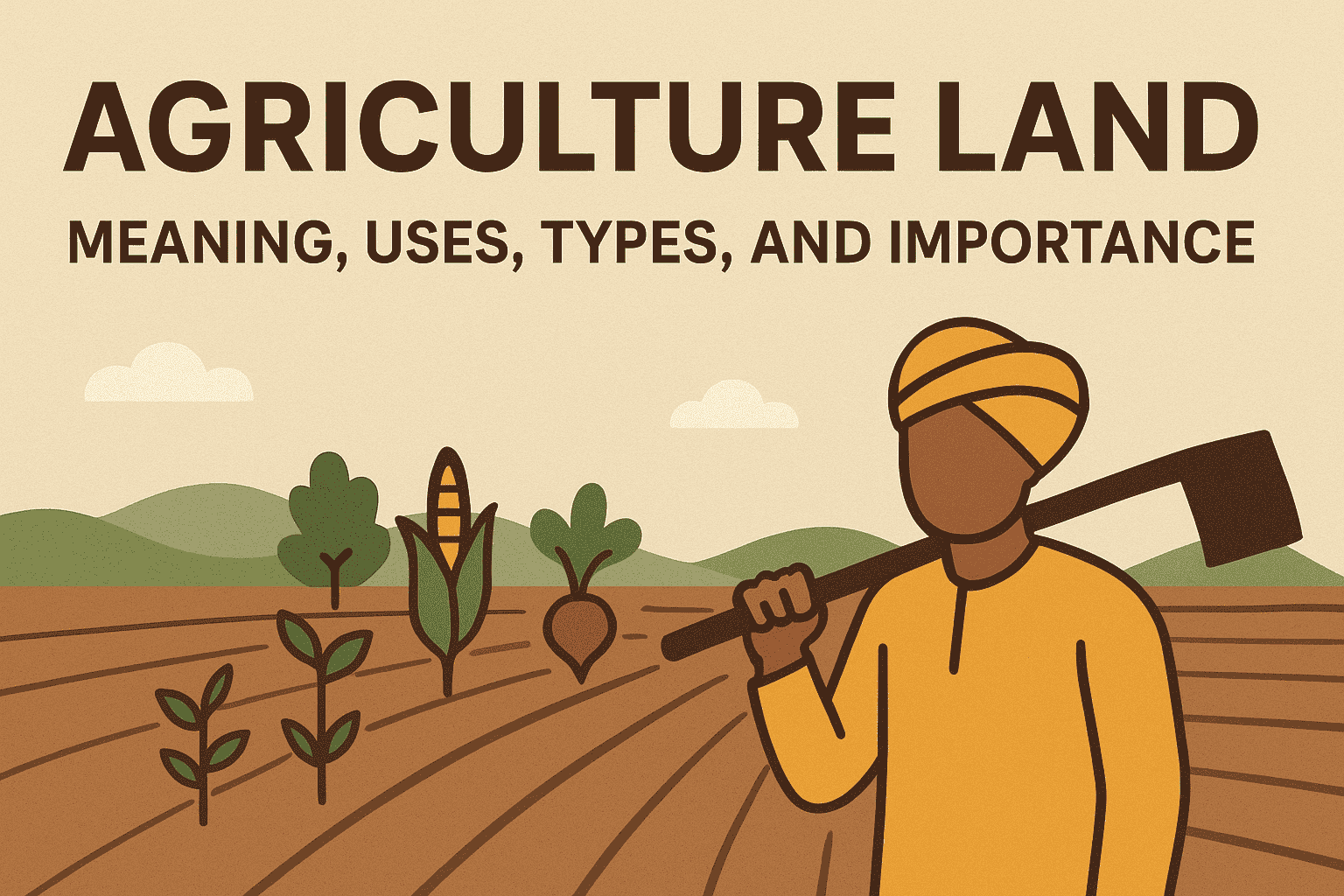Agriculture Land: Meaning, Uses, Types, and Importance
Agriculture has been the backbone of human civilization, and agriculture land plays a crucial role in sustaining food production, economy, and rural livelihoods. In India and across the world, farmland is not only used for cultivation but also serves as a valuable asset for investment.
In this article, we will cover:
- What is agriculture land?
- Different types of agriculture land
- Uses of agricultural land
- Importance for farmers and investors
- Rules for buying agriculture land in India
- FAQs on agricultural land
What is Agriculture Land?
Agriculture land, also called farmland or cropland, refers to land specifically used for farming and cultivation. It includes land where crops are grown, orchards, pastures, and areas used for irrigation.
As per the Revenue Department in India, agriculture land is land that is primarily utilized for farming activities and not for commercial or industrial use.
Types of Agriculture Land
Agricultural land can be categorized into several types based on fertility, irrigation, and usage:
- Crop Land – Used for growing food grains, vegetables, and cash crops.
- Orchards & Plantations – Land for fruits, spices, coffee, tea, and rubber.
- Pasture Land – Land for grazing livestock.
- Fallow Land – Land left uncultivated for a season to restore fertility.
- Irrigated Land – Land supported by canals, borewells, or dams.
- Rainfed Land – Cultivation dependent solely on rainfall.
Uses of Agriculture Land
Agriculture land serves multiple purposes, including:
- Food Production – Cultivation of crops, vegetables, fruits, and grains.
- Livestock Rearing – Grazing and fodder production for cattle, sheep, and goats.
- Horticulture – Production of fruits, flowers, and vegetables.
- Forestry – Timber, medicinal plants, and agroforestry practices.
- Renewable Energy – Solar and wind energy projects on farmland.
- Investment – Agriculture land is considered a long-term appreciating asset.
Importance of Agriculture Land
- Food Security – Ensures supply of essential grains, pulses, and vegetables.
- Employment – Agriculture provides livelihood to over 40% of India’s population.
- Economic Growth – Contributes significantly to India’s GDP.
- Environmental Balance – Maintains biodiversity and soil fertility.
- Cultural Value – Farmland is deeply connected with rural traditions and heritage.
Buying Agriculture Land in India
Buying agricultural land in India involves certain rules and restrictions that vary state to state:
- In many states (like Karnataka, Maharashtra, Gujarat), only farmers can buy agriculture land.
- Some states allow non-farmers to buy, but with special permission.
- Conversion Rules – Agricultural land must be converted to non-agriculture (NA) land for commercial or residential use.
- Buyers should check title deed, encumbrance certificate, land records, and mutation details before purchase.
- Land records can be verified online through portals like Bhulekh, Dharani, AnyROR, Jamabandi, depending on the state.
Benefits of Investing in Agriculture Land
- Low Investment, High Return – Farmland prices are lower compared to urban real estate.
- Appreciation in Value – Land value increases over time.
- Leasing Option – Land can be leased to farmers for cultivation.
- Tax Benefits – Income from agriculture is exempt from Income Tax in India (with certain conditions).
Challenges of Agriculture Land
While agriculture land is valuable, it also comes with challenges:
- Land disputes and unclear ownership.
- Water scarcity in rainfed areas.
- Conversion and legal restrictions on usage.
- Climate change affecting productivity
Conclusion
Agriculture land is one of the most valuable natural resources. It not only supports food production and employment but also serves as a profitable investment opportunity. With digital land record systems like Bhulekh, Dharani, and AnyROR, checking and verifying agricultural land ownership has become easier and more transparent.
Whether you are a farmer, investor, or property buyer, understanding the types, uses, and rules of agriculture land is essential before making any decision.
👉 For state-wise guides on land records and property verification, explore more articles on Bhulekh India.
FAQs on Agriculture Land
Q1. What is considered agricultural land?
Land used primarily for cultivation, farming, and horticulture is classified as agriculture land.
Q2. Can non-farmers buy agricultural land in India?
In some states yes, but in most states only farmers are allowed. Special permissions may be required.
Q3. Can agricultural land be used for residential purposes?
No, unless it is converted to non-agricultural land with government approval.
Q4. Is agriculture income tax-free in India?
Yes, agricultural income is exempt under the Income Tax Act, subject to conditions.
Q5. Which states have the most fertile agricultural land in India?
Punjab, Haryana, Uttar Pradesh, Andhra Pradesh, and West Bengal are known for fertile lands.
Related Articles:
What is Bhulekh? A Complete Guide to India’s Digital Land Records System
Understanding the Land Record Ecosystem of Uttar Pradesh
J&K Land Records Information System- Check J&K Jamabandi Records
Land Records Information System in India | Digital Land Records







